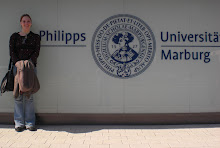We arrived in Munich at about 8 p.m. Walking out of the train station, I remember wanting to feel a kind of awe, anything that would say “Yes, Sara, this is going to be an awesome weekend in Bavaria.” Sadly, it was dark, cold and I had no such feelings. I trudged along behind the others and hoped that we would not get lost trying to find our hostel.
Richard was familiar with the city, having studied there for a semester, and we found it relatively easily. Next he wanted to visit the hostel that he had previously stayed in.
We walked to the Euro Youth Hostel and sat down at the bar. The place was full of young people conversing in all different languages, drinking and dancing. Everyone seemed so friendly and the atmosphere was very relaxed. I remember Tom saying that this was how he had always pictured a hostel to be like.
That night we met a Dutch man who was very impressed that Americans were speaking something other than English.
“When a person can speak three languages, they are trilingual. When a person can speak two languages they are bilingual. When a person only speaks one language, they are an American,” he said.
The next day I went on a tour of the concentration camp in Dachau with Tom. The concentration camp has been turned into a free memorial.
I did not know what to expect when visiting a concentration camp. Would I be upset by what I saw? Was this something I really wanted to experience? These were things I was mindful of as I walked through Dachau’s famous iron gates, the inscription “Arbeit mach frei” (work makes you free) looming above me.

Upon entering the gate, I was met by a harsh, barren landscape. I found myself standing in a square, surrounded by long, white buildings. Everything was still and before long, snow began falling out of the overcast sky. The crunching of gravel underfoot and the occasional explanation offered by a tour guide were the only sounds I heard for the next few hours.
The tour was in English, and the guide took our group through each of the white buildings explaining its previous uses and offering bits of history as well. Most of the tour was spent walking through barracks. I saw where prisoners slept, washed, ate, where some were tortured or experimented on, where their hair was cut and where names were exchanged for numbers and identities stolen.
I remember having this numb feeling for hours, walking silently and taking photos. How many people walked here before me? Worked here? Died here?
Near the end of the tour, I found myself outside of the gas chamber and crematorium. I was told that there was speculation as to if the gas chamber was ever actually used, but there was no doubt that the crematorium was.
I remember walking toward the gas chamber and seeing “Brausebad” (shower room) written above the door. The chamber was made of smooth concrete and had fake shower spigots on the ceiling.
Next I walked into another concrete room and instantly began to feel sick. The hairs on the back of my neck stood on end and panic gripped at my chest. After reading an inscription on the wall, I realized that I was standing in a room where bodies were housed before cremation. I quickly left the compound and the tour was finished shortly thereafter. A video of the compound is attached to this entry.
That night we met the rest of our traveling companions and went to the Hofbräuhaus. The Hofbräuhaus is a famous traditional Bavarian beer hall, which was a stark comparison to the concentration camp memorial. It was just what Tom and I needed.
According to J

eremy Gray, author of the Bavaria section of Lonely Planet's "Germany," says the Hofbräuhaus is “certainly the best-known and most celebrated beer hall in Bavaria, but apart from a few local yokels you’ll be in the company of tourists. A live band is condemned to play Bavarian folk music most of the day.”
This may have been true, but we enjoyed the Hofbräuhaus none the less. We were seated at a large wooden table with benches, and were served liters of beer by a waitress, dressed in a traditional dirndl (the female equivalent to lederhosen). I ate my weisswurst and thoroughly enjoyed the music played by the “condemned” band all night.
For more information about the Hofbräuhaus, please visit its official Web site at
http://www.hofbraeuhaus.de/en/index_en.html.
For more information about the Dachau Concentration Camp Memorial site, please visit its official Web site at
http://www.kz-gedenkstaette-dachau.de/english.html.
S.N.

 had to switch trains four times, but it was actually relatively easy and I suppose it was good practice for us as well. We got into Marburg at 10:20 that night.
had to switch trains four times, but it was actually relatively easy and I suppose it was good practice for us as well. We got into Marburg at 10:20 that night.




